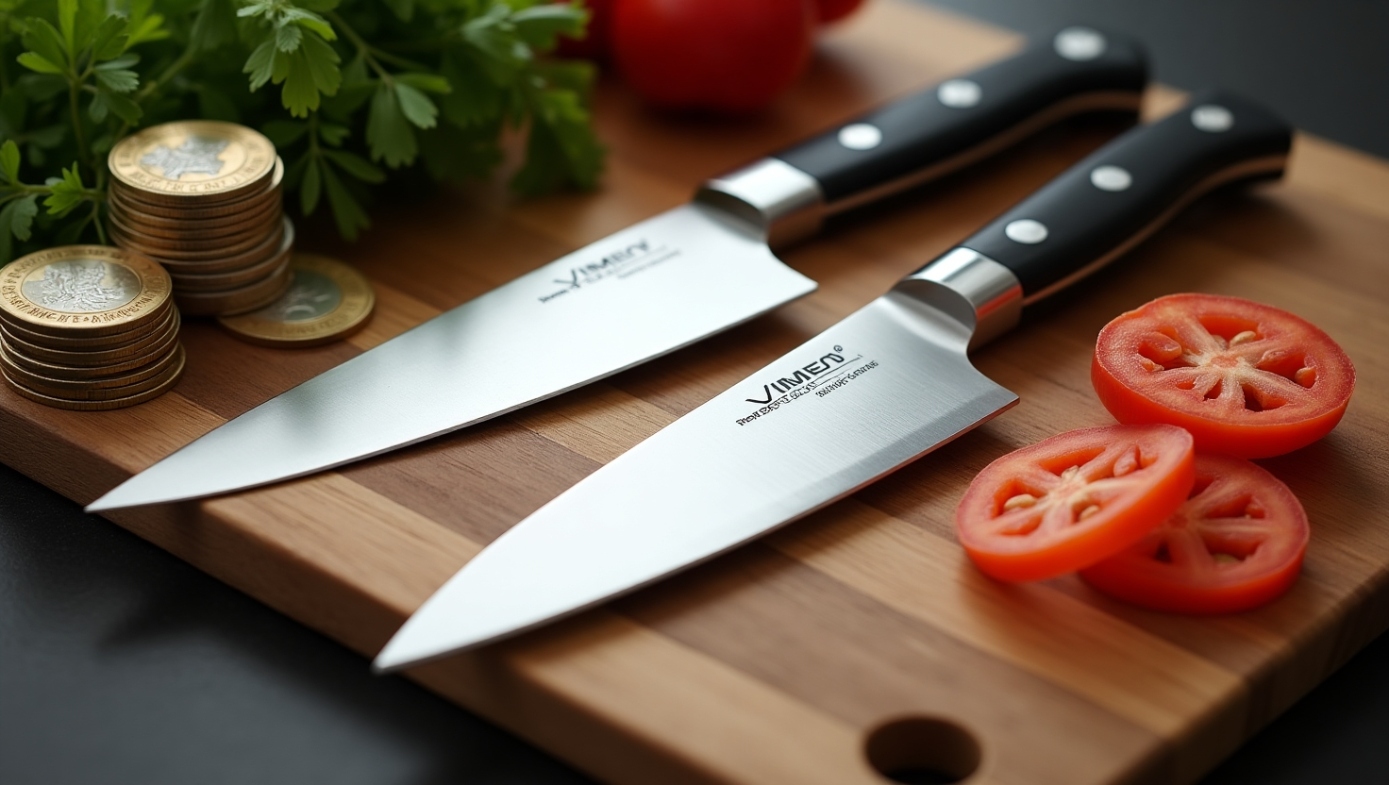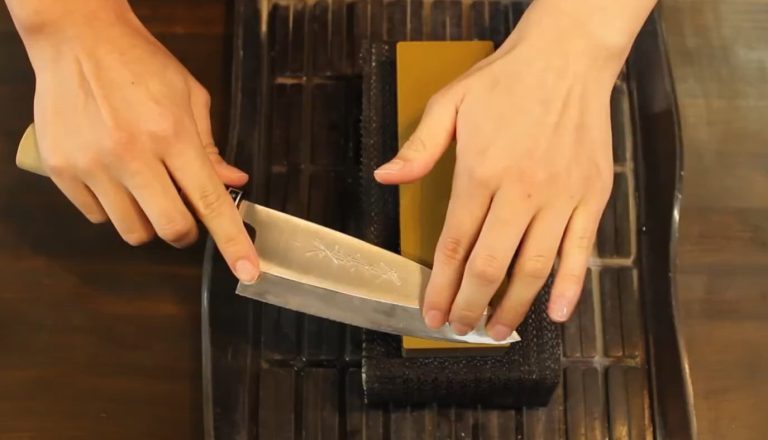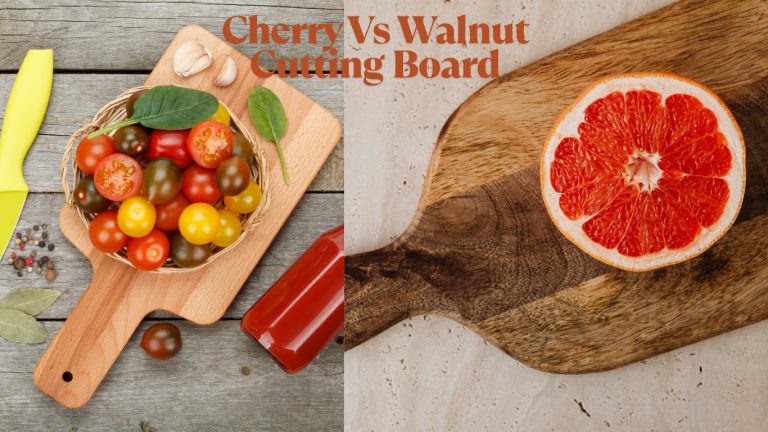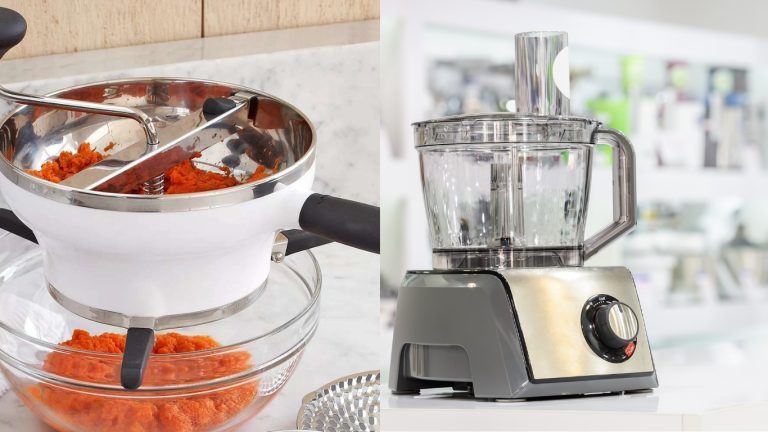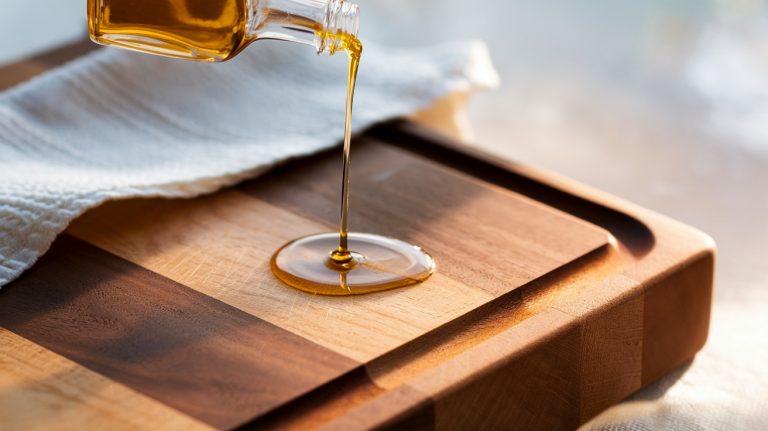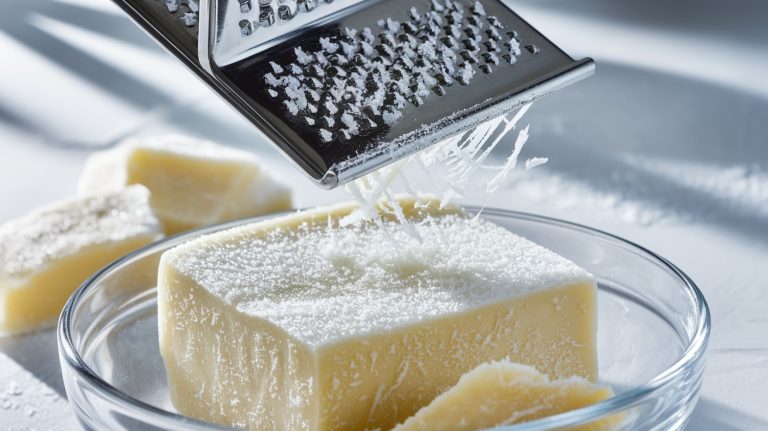Vg10 vs Sg2: Which Knife Steel Cuts Deeper?
When choosing between VG10 and SG2 for your knife, you’ll notice key differences. VG10, with 15% chromium, offers solid corrosion resistance and a hardness of 58-61 HRC, balancing sharpness and toughness.
SG2, at 63-64 HRC, excels in edge retention and wear resistance due to its fine microstructure. It’s tougher too, averaging 6.5 ft-lbs versus VG10’s 5.8. Curious about which suits your needs best? Stick around to uncover more insights.
Key Takeaways
- VG10 offers better corrosion resistance with 15% chromium, ideal for humid environments.
- SG2 has superior edge retention due to higher hardness (63-64 HRC).
- VG10 is easier to sharpen compared to SG2, using 400/1000 grit whetstones.
- SG2 is tougher (6.5 ft-lbs) than VG10 (5.8 ft-lbs), suited for demanding tasks.
- VG10 is more cost-effective, while SG2’s advanced manufacturing increases its price.
Steel Composition Overview
Diving into the heart of VG10 and SG2, you’ll find their steel compositions define their performance in high-demand applications.
You’ll notice VG10 boasts 0.95-1.05% Carbon for edge retention, 14.0-15.0% Chromium for corrosion resistance, 1.30-1.50% Cobalt for structural integrity, 0.9-1.2% Molybdenum for strength, and 0.15-0.50% Vanadium for durability.
These elements make VG10 a top choice for stainless steel blades in moist environments.
On the other hand, SG2, also a premium stainless steel, stands out with its refined carbide structure, enhancing its suitability for high-performance blades.
You’ll also find that SG2 offers superior edge retention due to its high carbon content and powder metallurgy process.
You’ll appreciate how both steels leverage advanced production, with VG10’s powder metallurgy ensuring uniformity.
Additionally, VG10 achieves a hardness range of 58-61 HRC, balancing sharpness and toughness for long-lasting performance hardness range.
Hardness and Toughness Analysis
As you explore the nuances of VG10 and SG2, you’ll notice their hardness and toughness play critical roles in determining their suitability for high-performance applications.
Both steels boast similar hardness values, around 60.7 Rc, achieved through comparable heat treatments, though SG2’s austenitization occurs at a slightly higher 2000°F compared to VG10’s 1975°F. This hardness guarantees solid edge retention but can impact toughness.
When analyzing toughness, you’ll find SG2 edges out VG10, averaging 6.5 ft-lbs versus 5.8 ft-lbs in tests. Additionally, SG2 benefits from a fine microstructure due to its powder metallurgy process, further enhancing its toughness and resistance to wear.
SG2’s powder metallurgy process and higher carbide content enhance this balance, preventing chipping while maintaining sharpness. Though both steels rank high in toughness, SG2’s slight advantage makes it more resilient under demanding conditions, assuring reliable performance.
Corrosion Resistance Comparison
As you compare VG10 and SG2 for corrosion resistance, note that VG10’s 15% chromium content offers solid protection, while SG2’s slightly higher range of 14-16% provides a marginal edge in resisting rust.
You’ll find both steels excel in wet environments, like kitchens or humid conditions, making them reliable for demanding applications. Additionally, steels with over 10% chromium are generally classified as stainless, ensuring robust corrosion resistance for both VG10 and SG2 in challenging conditions.
Consider how this chromium impact and suitability for moisture-rich settings influence your choice for long-term durability.
Chromium Content Impact
Take a close look at the chromium content in VG10 and SG2, as it’s a critical factor in determining their corrosion resistance. VG10 offers around 15% chromium, ensuring robust protection through chromium in solution, though some forms carbides, slightly reducing effectiveness.
SG2, with 14-16% chromium, matches or edges out VG10, benefiting from a design that limits excessive carbide formation, preserving more chromium for corrosion resistance. This composition, achieved through powder metallurgy, ensures superior structural uniformity in SG2.
You’ll notice SG2 rates marginally higher at 8/10 versus VG10’s 7/10, thanks to its powder metallurgy process enhancing homogeneity.
Both steels leverage additional elements—VG10 with cobalt and molybdenum, SG2 with vanadium—bolstering their resistance.
Understand that balancing chromium in solution against carbide formation is key to their performance against rust and pitting.
Wet Environment Suitability
When evaluating VG10 and SG2 for wet environment suitability, you’ll find both steels excel as high-carbon stainless options designed to resist corrosion in challenging conditions.
Their stainless nature guarantees durability in marine settings, high humidity, and acidic or salty environments. However, SG2 holds a slight edge with a corrosion resistance rating of 8 compared to VG10’s 7, thanks to its carbide structure and higher vanadium content.
You’ll notice both steels resist moisture well, essential for kitchen or marine applications. SG2 performs remarkably in saltwater tests, while both handle distilled water effortlessly.
Additionally, the high chromium content in both steels enhances corrosion resistance, making them reliable choices for prolonged exposure to wet conditions.
Edge Retention and Wear Performance
Plunge into the critical comparison of edge retention and wear performance between VG10 and SG2, two high-performing stainless steels.
You’ll notice SG2 outperforms VG10, thanks to its higher vanadium content forming harder carbides, boosting wear resistance by about 10%. While VG10 suits general use, SG2 excels in high-precision tasks demanding sustained sharpness.
Additionally, SG2’s higher hardness rating of 63-64 HRC contributes to its superior wear resistance compared to VG10’s 61 HRC.
It’s worth noting that VG10, while slightly less durable in edge retention, offers better toughness for handling stress without breaking, as seen in comparisons with similar steels like AUS-10 better toughness handling.
Check these key differences to guide your choice:
- Edge Retention: SG2 maintains sharpness longer than VG10 under prolonged use.
- Wear Resistance: SG2’s vanadium carbides enhance durability against tough materials.
- Application Fit: Pick VG10 for everyday tasks; opt for SG2 for precision cutting.
- Durability: SG2 resists wear better, though VG10 handles abuse without micro-chipping.
Sharpening and Polishing Insights
As you immerse yourself in the nuances of sharpening and polishing, you’ll find distinct differences between VG10 and SG2 that impact maintenance.
VG10 sharpens more easily than SG2 due to fewer vanadium carbides, though it’s trickier than CPM-154. Use a 400/1000 grit whetstone for VG10 to form a burr efficiently.
Polishing VG10 is simpler compared to SG2, as its lower carbide content responds well to standard abrasives. Consistent sharpening angles are essential to preserve the blade’s performance and prevent damage over time sharpening angles essential.
Remember that regular honing can maintain sharpness and reduce the need for frequent full sharpenings regular honing benefits.
Here’s a precise comparison:
| Aspect | VG10 |
|---|---|
| Sharpening Ease | Easier than SG2, harder than CPM-154 |
| Grit Recommendation | 400/1000 whetstone |
| Polishing Ease | Simpler than SG2 |
| Carbide Impact | Fewer, aids polishing |
| Technique Consistency | Critical for edge maintenance |
Cost and Versatility Factors
Plunge into the critical aspects of cost and versatility, and you’ll quickly notice stark contrasts between VG10 and SG2 that influence your purchasing decision.
When analyzing these steels, cost often tips the scale. VG10 offers a broader price range, including budget options under $100, while SG2’s advanced manufacturing drives its higher cost, especially in premium models.
Additionally, the performance of VG10 can vary significantly depending on the manufacturer and heat treatment heat treatment quality.
Moreover, similar to comparisons between stainless and carbon steel, VG10 tends to be more resistant to corrosion than many alternatives, making it a practical choice for varied environments corrosion resistance benefits.
Consider these key factors for a precise choice:
- Affordability: VG10 knives won’t strain your wallet, unlike pricier SG2.
- Edge Retention: SG2’s superior sharpness longevity justifies its cost for precision needs.
- Maintenance: You’ll find VG10 easier to sharpen compared to SG2.
- Availability: VG10’s widespread use means more options than the niche SG2.
Application Suitability
Moving from cost and versatility considerations, let’s focus on how VG10 and SG2 perform in specific applications.
If you’re crafting kitchen knives or working in humid environments, VG10’s high chromium content (14.5-15.5%) offers superior corrosion resistance, making it ideal for wet conditions.
Its ease of sharpening also suits you if maintenance is a priority. Additionally, VG10’s balanced hardness of HRC 60-62 ensures excellent edge retention for consistent performance in the kitchen.
On the other hand, if you’re tackling demanding cutting tasks, SG2’s higher toughness (6.5 ft-lbs vs VG10’s 5.8 ft-lbs) and exceptional edge retention, thanks to its carbide structure, make it your go-to for durability under stress.
Understanding that material choice affects knife performance can guide your decision between these two steels.
While SG2 demands more effort in sharpening, its performance in high-impact scenarios outshines VG10.
Key Differences Summary
While we’ve explored application suitability, let’s now break down the core distinctions between VG10 and SG2 in this key differences summary.
You’re choosing between two premium steels, but their properties vary considerably. Analyze these critical differences to decide which suits your needs.
Navigating the choice between premium steels? Their unique properties differ significantly, so weigh these distinctions to find your perfect match.
Here’s a concise breakdown of key contrasts:
- Edge Retention: SG2 outperforms with higher vanadium content, holding sharpness longer.
- Sharpening Difficulty: VG10’s easier to sharpen, rated 6, while SG2’s at 4 due to vanadium carbides.
- Corrosion Resistance: SG2 edges out with a rating of 8 versus VG10’s 7, thanks to cobalt.
- Cost: SG2’s pricier, reflecting its superior performance and manufacturing complexity.
Additionally, consider durability when making your choice, as VG10 is often noted for its ability to withstand abuse compared to SG2.
Frequently Asked Questions
Which Steel Is Better for Outdoor Use?
When choosing a steel for outdoor use, you’ve gotta prioritize corrosion resistance, edge retention, and toughness.
Look for a material that withstands moisture, holds a sharp edge during extended tasks, and resists chipping under impact.
You’ll want a steel that balances these traits for rugged environments.
Between your options, SG2 edges out slightly with superior toughness and edge retention, making it ideal for demanding outdoor cutting and heavy-duty use.
How Do They Perform in Extreme Temperatures?
When you’re evaluating steel performance in extreme temperatures, you’ll notice both materials handle heat with precision.
Explore their behavior under stress; you’ll find they maintain hardness through a martensitic structure post-quenching.
Expect stability thanks to high chromium and molybdenum content.
You’ll see they resist cracking with careful tempering, ensuring durability.
Trust that their heat tolerance, around 1975-2000°F during quenching, makes them reliable for demanding, high-temperature environments.
Are There Notable Differences in Weight?
You’re likely wondering if there are notable differences in weight when comparing materials in knife construction.
Don’t expect significant variations based solely on the steel type. You’ll find that density differences are minimal between high-quality stainless steels.
Instead, pay attention to blade design and geometry—they’re the real drivers of weight.
Focus on the overall build and size; that’s where you’ll notice the impact, not in the steel composition itself.
Which Steel Is More Environmentally Friendly?
When weighing which steel treads lighter on Mother Earth, you’ve gotta dig into the environmental impact with precision.
Assess the energy-intensive extraction of alloying elements and production emissions. Scrutinize mining footprints and refining processes that drain resources.
Don’t overlook durability—longer-lasting materials cut waste. Factor in recycling potential and modern manufacturing efficiencies.
How Do They Handle Repeated Impacts?
When you’re evaluating how materials handle repeated impacts, focus on toughness and structural integrity under stress.
You’ll notice that impact resistance hinges on grain structure and carbide content, which can influence brittleness.
Assess unnotched Charpy test results to gauge energy absorption—higher values mean better performance.
Don’t overlook edge retention, as it ties into durability.
Keep sharpening difficulty in mind too, as it affects long-term usability after repeated stress exposure.
VG10 vs SG2: The Cut That Fits Your Style
As you weigh VG10 against SG2, consider this striking fact: SG2 boasts a hardness of up to 64 HRC, surpassing VG10’s typical 60 HRC, giving you superior edge retention.
You’ll find SG2’s micro-carbide structure offers exceptional wear resistance, though VG10’s ease of sharpening might suit your needs better.
Analyze your priorities—durability or maintenance—and choose wisely. Both steels excel, but your specific application will dictate the ultimate winner in performance.

